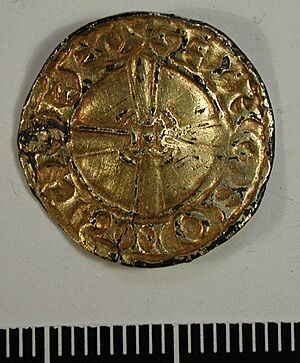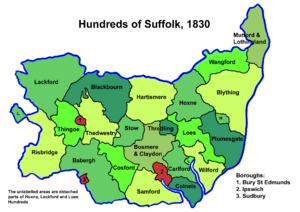History of Suffolk facts for kids
The county of Suffolk is in England. This article tells you about its long and interesting history.
Contents
Early History and Anglo-Saxons
Suffolk means 'southern folk'. It was formed from the southern part of the kingdom of East Anglia. This area was settled by the Angles in the late 400s. Important early settlements were at Sudbury and Ipswich.
Before the Norman Conquest, strong castles were built at Eye, Clare, Walton, and Framlingham. Suffolk became a separate county just before the Normans arrived. For a long time, Suffolk and Norfolk shared the same sheriff, who was like a chief officer. This changed in 1575.
The county's borders have stayed mostly the same. However, some parts of Gorleston and Thetford that were once in Suffolk are now in Norfolk. In 1888, Suffolk was divided into two administrative areas: East Suffolk and West Suffolk.
How the Land Was Divided
Long ago, the whole county was part of the church area called the diocese of Dunwich. This was set up around 631. Later, a new bishopric was made for Norfolk. When the Danes invaded, the Dunwich diocese ended. Suffolk then became part of the Elmham diocese, which later moved to Norwich.
The county was also divided into areas called 'hundreds'. These were used for local government. In 1831, Suffolk had twenty-one hundreds and three main towns. Many of these hundreds were the same as those listed in the Domesday Book from 1086.
Some large areas were known as 'liberties'. In these places, the king's laws didn't always apply directly. For example, the Liberty of St Edmund covered several hundreds. Another was the Liberty of St Aethelreda of Ely. Important families like the Bigods and the De la Poles also owned large lands and had special powers.
For government, the Liberty of Saint Edmund and the rest of the county were treated separately. They each had their own jury. The county was also divided into areas where fines went to the King, and areas where they went to the local lord. Over time, these divisions changed. By 1890, they formed the basis for East and West Suffolk.
From Vikings to Civil War
Suffolk faced many attacks from the Danes. After a peace treaty, it became part of the Danelaw, an area ruled by Danes.
In 1173, the Earl of Leicester landed in Walton with an army. He joined forces with Hugh Bigod against King Henry II. Later, in 1317, many people in Suffolk supported Thomas, 2nd Earl of Lancaster. In 1381, there was a big uprising of farmers, especially near Bury St Edmunds.
During the Wars of the Roses, Suffolk mostly supported the Yorkist side, but didn't play a huge role. In 1525, people in the south of the county resisted King Henry VIII's forced taxes. Later, Mary Tudor gathered her army from Suffolk to claim the throne.
During the English Civil War, Suffolk mostly supported the Parliament. It joined other eastern counties to defend against the King's supporters.
Economy and Trade
Suffolk sent two representatives to parliament from 1290. In 1832, the county gained four members. At that time, some smaller towns like Dunwich and Aldeburgh lost their right to send members to parliament.
Suffolk was one of the most populated English counties. This was probably because it was close to mainland Europe. Fishing boats from Suffolk ports brought back cod, ling, herring, and mackerel.
From the 1300s to the 1600s, Suffolk was a major manufacturing county. It was famous for its cloth-weaving industry, which was very successful in the 1400s. In the 1600s and 1700s, Suffolk's farms helped feed the growing city of London.
Later, other industries grew, like making sail-cloth, coconut fiber, and clothing. Silk weavers moved to Suffolk from London. In the early 1800s, an important china factory operated in Lowestoft.
Historic Buildings and Remains
Suffolk has many old buildings and ruins.
Monasteries and Churches
The most important monastery ruins are those of the great Benedictine abbey in Bury St Edmunds. Clare College, once a religious house, is now a boarding school but still has old architecture. You can also see parts of the Augustinian priory at Butley and the Grey Friars monastery at Dunwich.
Many churches in Suffolk use flint for decoration, especially on porches and tower tops. Another special feature is the round towers, which are common in East Anglia. Good examples are at Little Saxham and Herringfleet. Most churches are in the Perpendicular Gothic style. Famous examples include Blythburgh, Lavenham, and Long Melford.
Castles and Homes
You can find parts of old castles like Bungay Castle, which belonged to the Bigods. There are also the ruins of Mettingham and Wingfield, which still has its moat and drawbridge. Framlingham Castle is a grand ruin with high, strong walls. It was founded in the 500s and rebuilt in the 1100s. Clare Castle was once home to the Earls of Clare. Orford Castle has a fine Norman tower overlooking the sea.
Many beautiful old homes are in Suffolk. Hengrave Hall (around 1530) is a lovely building of brick and stone with a courtyard. Helmingham Hall is a Tudor mansion made of brick, surrounded by a moat with a drawbridge. West Stow Manor is also Tudor, but it has been changed into a farmhouse.
Along the coast, Suffolk has many Martello towers. These were built in the early 1800s to protect against a possible invasion by Napoleon Bonaparte's France.
See also
- Hundreds of Suffolk
- Suffolk History Hub



